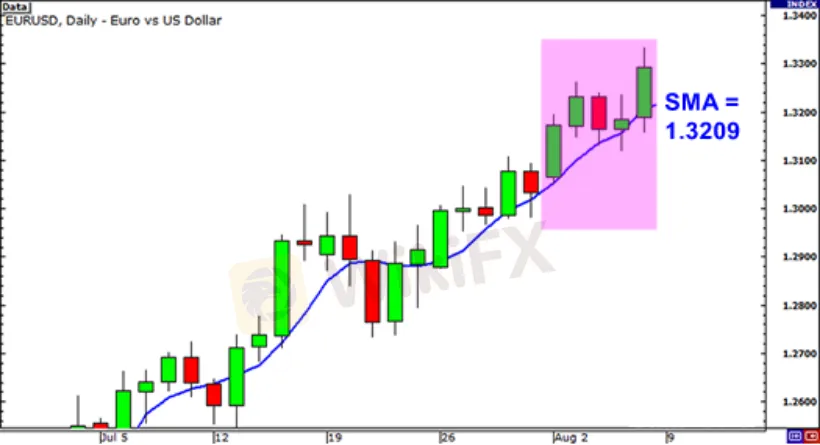简体中文
繁體中文
English
Pусский
日本語
ภาษาไทย
Tiếng Việt
Bahasa Indonesia
Español
हिन्दी
Filippiiniläinen
Français
Deutsch
Português
Türkçe
한국어
العربية
Exponential Moving Average (EMA) Explained
Abstract:As we have previously discussed and explained that, simple moving averages (SMA) can be twisted or misinterpreted by spikes. We have some examples below to start with. Supposed we plot a 5-period SMA on the daily chart of EUR/USD.
As we have previously discussed and explained that, simple moving averages (SMA) can be twisted or misinterpreted by spikes. We have some examples below to start with.
Supposed we plot a 5-period SMA on the daily chart of EUR/USD.

The end prices for the last 5 days are as follows:
Day 1: 1.3172
Day 2: 1.3231
Day 3: 1.3164
Day 4: 1.3186
Day 5: 1.3293
The simple moving average would be calculated as follows:
(1.3172 + 1.3231 + 1.3164 + 1.3186 + 1.3293) / 5 = 1.3209
The simplification seems quite simple right?. Good, Let‘s see if there was a news report on Day 2 that causes the euro to drop across the board. This causes EUR/USD to plunge and close at 1.3000. Let’s see what effect this would have on the 5-period SMA.
Day 1: 1.3172
Day 2: 1.3000
Day 3: 1.3164
Day 4: 1.3186
Day 5: 1.3293
The simple moving average would be calculated as follows:
(1.3172 + 1.3000 + 1.3164 + 1.3186 + 1.3293) / 5 = 1.3163
Due to the change on Day 2 that causes Euro to drop, the newly simplified results of the SMA would be a lot lower and it would give you the idea that the price was actually going down when in reality, Day 2 was just a one-time event caused by the poor results of an economic report. The key objective we are trying to make is that, sometimes the simple moving average (SMA) might be too easy.
Unless you able to find a way that you could filter out these spikes, that you wouldnt get the wrong idea. Huh... just Wait..Yes ! Because there is a way named as Exponential Moving Average!
The exponential moving average (EMA) is a weighted average of recent period's prices. It uses an exponentially decreasing weight from each previous price/period.
Exponential moving averages (EMA) give more weight to the most recent periods.
In the above example the EMA would put more weight on the prices of the most recent days, which would be Days 3, 4, and 5.
This would mean that the spike on Day 2 would be of lesser value and wouldnt have as big an effect on the moving average as it would if we had calculated for a simple moving average. If you think about it, this really makes a lot of sense because it does put more emphasis on what traders are doing recently.
Exponential Moving Average (EMA) vs. Simple Moving Average (SMA)
Now Lets take a look at the 4-hour chart of USD/JPY to feature how a simple moving average (SMA) and exponential moving average (EMA) would look side by side on a chart.

Consider how the red line (the 30 EMA) seems to be a closer price than the blue line (the 30 SMA).
This means that it represents more accurately the recent price action. You can probably guess why this happens. Its because the exponential moving average drops more emphasis on what has been happening lately.
Note, When trading, it is far more important to see what traders are doing NOW rather than what they were doing last week or last month. Because thats the only way to get along.
Disclaimer:
The views in this article only represent the author's personal views, and do not constitute investment advice on this platform. This platform does not guarantee the accuracy, completeness and timeliness of the information in the article, and will not be liable for any loss caused by the use of or reliance on the information in the article.
Read more

Forex is a game that I enjoy playing
These champions have one thing in common: they not only work their butts off, but they also enjoy what they do.

Wait patiently. Maintain your discipline
"Patience is the key to everything," American comic Arnold H. Glasgow once quipped. The chicken is gotten by hatching the egg rather than crushing it."

There isn't a Holy Grail to be found!
Ask any Wall Street quant (the highly nerdy math and physics PhDs who build complicated algorithmic trading techniques) why there isn't a "holy grail" indicator, approach, or system that generates revenues on a regular basis.

Concentrate on the Process. Profits aren't a priority
We've designed the School of WikiFX as simple and enjoyable as possible to help you learn and comprehend the fundamental tools and best practices used by forex traders all over the world, but keep in mind that a tool or strategy is only as good as the person who uses it.
WikiFX Broker
Currency Calculator






